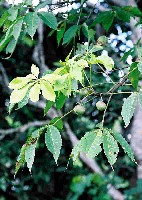| DESCRIPTION: It is a fast-growing tree, reaching 30-50 m in height and 2.7 m in girth. Sometimes it is only 7-10 m. Bole straight with short buttress, bark grey, smooth at first, becoming scaly with ageing. Leaves alternate, digitately 3-5 foliate. Inflorescence yellow tomentose, male panicles are up to 41 cm long, while female panicles shorter and stouter. Fruit indehiscent, 2-3 lobed, 2 celled, with a thick, hard shell containing 2-3 red-brown-black seeds, rounded, flat, over 1 cm across. USE: The seeds can be eaten after they have been boiled or roasted. The wood is fibrous, soft, light and perishable. Used for rough planks, coffins, fishing net floats and rafts for heavy timbers. The seed oil is light, yellow, drying and usable in varnish and soft soaps and has industrial application in waterproofing materials. The root is taken is used against constipation and as an antidysentery. The bark is tie to the body after it has been beaten and warmed to cure elephantiasis. A bark decoction is taken in Gabon for blennorrhoea and painful menstruation and as a poison antidote. When not grown in pure stands, it has always been intercropped with coffee, cocoa or bananas. Also used as an ornamental and he cake from seed-oil extraction is a good nitrogenous fertilizer. GROWING PERIOD: Perennial. COMMON NAMES: African nut tree. FURTHER INF: It is a tree of the fringing, deciduous and secondary forests common throughout the semi-dry, wooded-savannah zone of the region. From lower Senegal to west Cameroon and Fernando Po, to Democratic Republic of Congo, Angola and Tanzania, where it is found scattered in gaps at forest edges and in secondary scrub and thickets. |
